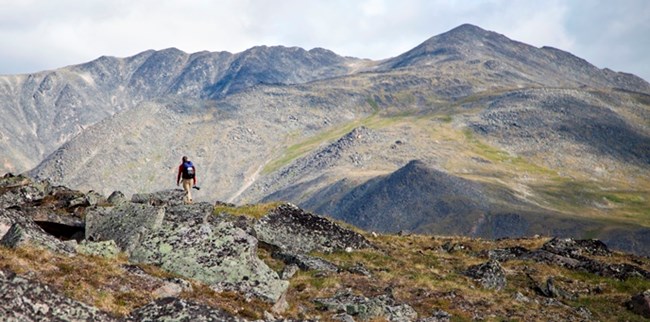
NPS/Greg Kinman Nothing inspires you to conserve the earth's beauty more than spending time in the wilderness, like a ten-day off-trail backpacking trip through the upland wilds of Yukon-Charley Rivers National Preserve in eastern Interior Alaska. We traveled by bush plane, landing on a tall grass valley in an area near Copper Mountain and the Charley River headwaters. It was an amazing experience; we shared the landscape with the caribou, wolverines, marmots, and bears (although we saw none; not even tracks or scat). And, we brought cameras. The sole purpose of our trip was to visually document the area so that others can be inspired to come responsibly enjoy and experience this incredible landscape. We landed in a Helio Super Courier on a relatively smooth bush airstrip in the mountain valley. Immediately surrounding the strip on all sides is an alpine wetland, filled with tussocks, moss, and watery, squelchy ground. Note to anyone traveling off-trail in Alaska; try to travel with a light pack so that you can wear lighter shoes, such as trail runners, that dry quickly. Even if you wear the top-of-the-line waterproof backpacking boots, your feet will still get soaked, so you might as well give up on trying to keep your feet dry and instead wear shoes that don't stay wet. You'll also travel faster and easier with a lighter load. 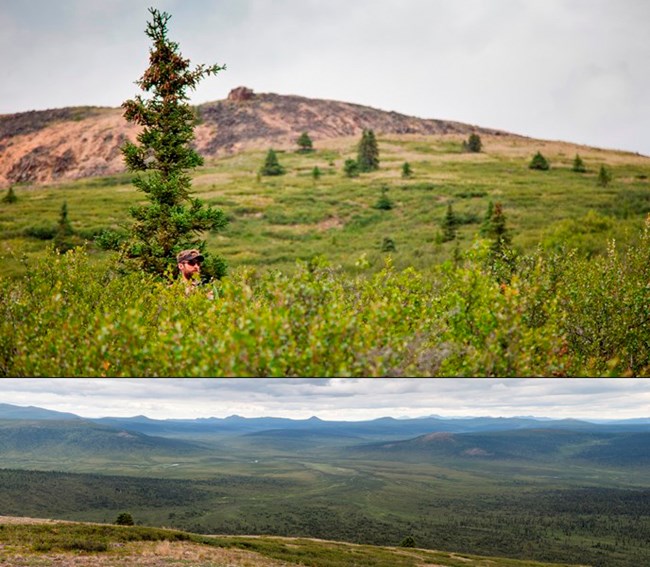
NPS/Greg Kinman We slogged through the tussocks up to higher ground, where the water drains well enough to allow spruce trees and brush such as dwarf birch to grow in dense thickets. Wear long sleeves and gaiters in these sections, or your arms will be scratched and your pants will get ripped! As elevation increases, however, the trees and brush reduce in size significantly until they are no longer present. Once we were above the tree line, the landscape moved to grasses and flowers in the wetter areas and low moss, rock, and berry plants in the drier areas. Sadly, we were a few weeks too early for berry season; we only found about three blueberries that were ripe enough to eat. We had our heads forward for so long, sweating and slogging through thick brush uphill, yelling 'yogi!' constantly to notify any bears that might be in the area that we were passing through, that we hadn't looked back behind us for a while. When we did, we saw the beautiful basin that we had left. We noticed that the airstrip, which is about 800 feet long, looked like a tiny speck compared to the rest of the landscape. It's amazing how small we began to feel after being immersed in a wilderness like Yukon-Charley Rivers. 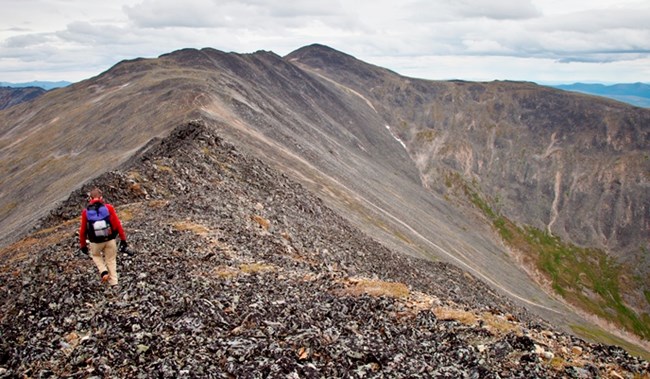
NPS/Greg Kinman However, the fact that not even we, backcountry staff of the National Park Service, had been aware of the level of ruggedness of the second highest peak in the preserve, goes to show the deep level of wilderness that abounds in Alaska. Alaska's wilderness areas are absolutely untouched compared to designated wilderness areas in the contiguous United States.
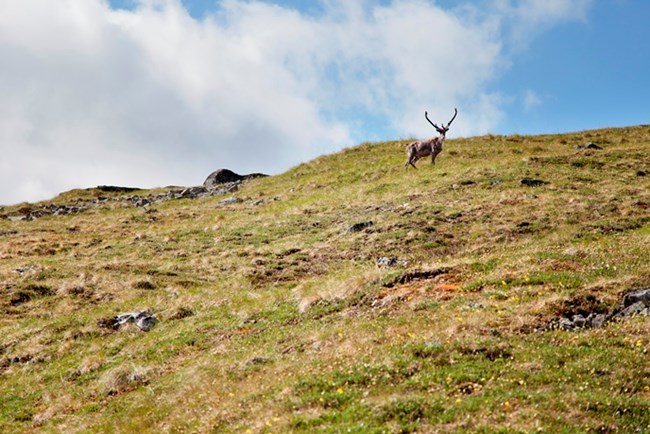
NPS/Greg Kinman As we hiked up the ridge on our summit attempt, we had a few encounters with bull caribou. They made experienced hikers like us look like crawling babies what with their ability to prance around on mossy and rocky ridgeline slopes. Throughout the trip, we saw around five caribou while on the ground, as well as an entire herd of at least fifty on the return flight out of the preserve. The nice thing about seeing lots of caribou is that their presence precludes that of bears for at least a little while! We spotted two Dall sheep on a ridge across the valley towards Copper Mountain, and we heard an enormous amount of marmots and pika squeaking with disapproval at our presence on the alpine rocky slopes. Listen to the marmots; their squealing calls may be letting you know of the presence of an unwelcome creature (a bear) near your camp. The icing on the wildlife cake, however, was the sighting of two wolverines on two consecutive days near the end of the trip. Most wilderness travelers go their entire lives without seeing a single wolverine, and we saw two. The Athabaskans, the natives of Interior Alaska, consider the wolverine their chief animal for its strength, agility, speed, and ability to inspire fear in all other animals, despite its small size. Seeing the wolverines, although only for a few seconds each, was an amazing experience. Josh even got a video of the first encounter. 
NPS/Greg Kinman 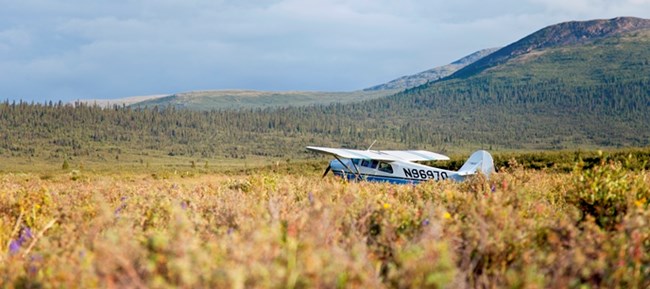
NPS/Greg Kinman After having eaten four more days of food, our packs were significantly lighter heading back up the ridge than they had been coming down it. We backtracked our incoming path relatively quickly, making our way back to the airstrip in two days. We had set up camp at the airstrip the night before our pickup date when we heard the hum of a plane overhead. We looked up in the sky out of our shelter, and circling the airstrip was a small bush plane, but not the one that was to come pick us up! We quickly removed our tent from the middle of the airstrip and let the plane land. A local bush pilot, Dave, was simply resting at the strip for the night before continuing on to get some more fuel. It wasn't long after Dave took off that we did as well. As we flew low and weaved through the mountains on the flight out of the preserve, I was looking forward to some fresh food, but I was also sad to leave such a pristine wilderness. It's a place for reflection, and it's a reminder that, without technology, humans are simply inferior to native wildlife in this natural environment. Hopefully my images can convey that sentiment. |
Last updated: October 20, 2015
